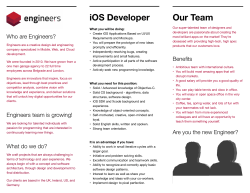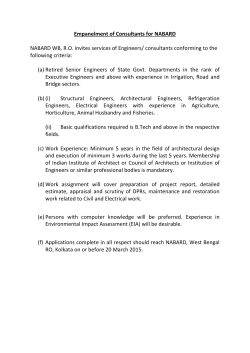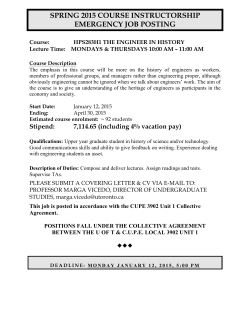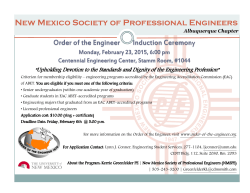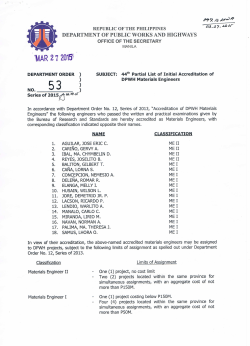
Letters - Daniel Liberzon
Feedback I EEE Control Systems Magazine warmly welcomes your letters on any aspect of this magazine or control technology. Letters may be edited in consultation with the author. Please send all letters by post or e-mail to the editor-in-chief. Control engineers provide significant contributions I read and enjoyed the editorial “Perceptions of Science and Engineering,” [1] in the October 2014 issue, and I would like to comment on the reasons why perceptions of engineering may have propagated so poorly. I believe the public’s view of engineers is heavily distorted by the media. For example, in shows like The Big Bang Theory, the engineers are made fun of and portrayed as physicists who could not make it (for example, engineers are called the “Oompa-Loompas of science” on the show). Also, in which movie has the engineer been shown to be the hero? When do engineers save the world in movies? We are not advertised in a way that shows our contribution, yet we are responsible for the majority of technology development and are one of the most heavily funded professions. It appears that it is possible for the public to easily see engineers as a jack of all trades and, therefore, a master of none compared to physicists, chemists, biologists, and mathematicians because engineers pull from those fields to solve real-world problems. Digital Object Identifier 10.1109/MCS.2014.2385142 Date of publication: 17 March 2015 From discussions with some physicists and applied mathematicians, it appears they believe control engineers are less capable of providing any significant benefit or contribution (with the possible exception of getting things fabricated) because our focus is not entirely in either area but is pulled from both. We are viewed as more automatons than autonomous thinkers. Astrophysicists may be concerned with the physics of the sun, asteroids, Earth’s magnetic field, or some other planetary body. However, engineers are crucial to the modeling of these systems because we design and fabricate the spacecraft needed to host the instrumentation and perform the science mission and devise the parameter identification schemes and data collection procedures needed to seed the models that the astrophysicists develop. Without the spacecraft, data, and the estimation processes, the model would never be verified. Also, the spacecraft may have stringent pointing or orbit requirements, which are achieved by control engineers. Mathematicians may find a rigorous way of solving a problem through an elegant mathematical procedure. However, this procedure may not take into account all of the relevant constraints on the problem known by the engineers. In reality, when you break down a complex physical system, many of the solutions provided by current mathematical techniques may not be applicable (for example, the linear system assumption for a nonlinear system). Therefore, to solve problems, it is up to the engineer to find, where applicable, the available mathematical techniques and to develop them where « they do not exist. This would explain the reason why there are many control conferences where applied mathematicians and engineers attend to show off their newest algorithms, such as control conferences associated with IEEE and SIAM. When mathematicians, physicists, and engineers work together seamlessly and respect each other’s contribution, theory and technology will advance at a higher pace. I just wanted to share my comments, opinions, and experiences. Thank you. Frederick A. Leve, Ph.D. Reference [1] R. D. Braatz, “Perceptions of science and engineering,” IEEE Control Syst., vol. 33, no. 5, pp. 6–7, Oct. 2014. Author’s Response Thanks for your interesting perspective. Richard D. Braatz Leaving a lasting Mark Optimizing some utility function is at the heart of many human activities and processes occurring in nature. Engineering designs often aim to achieve or approximate some optimal performance, while figuring out the right utility function is a major first step toward explaining the behavior of a complex system. Here I would like to apply this principle to try to accomplish a goal that is both philosophical and practical: to better understand how we do research and go about related professional tasks. The current academic environment, at least in engineering departments in the United States, encourages APRIL 2015 « IEEE CONTROL SYSTEMS MAGAZINE 19 The two forms of utility functions described above—the short-term sum and the long-term max—lead to very different, even conflicting, optimal strategies. faculty members to publish many papers, raise a lot of research funds, graduate many students, and in general to be “active,” “productive,” “industrious,” “prolific,” etc. The system rewards such individuals by granting them promotions and tenure, giving them salary raises and awards, and placing them in positions of prominence at their institutions and professional societies. If we try to imagine a utility function that this kind of behavior optimizes, we realize that it has two important features. First, this is shortterm optimization. Indeed, salary raises are typically based on one’s performance over the past year; the time horizon for promotion and tenure decisions is only slightly larger, typically around five years or fewer. Second, since each additional paper published, research grant awarded, and dissertation supervised counts toward the overall goal, this shortterm utility function takes the form of a sum. With some effort, it can be made into a weighted sum where, for example, publications in top-tier journals are considered more important. Still, such utility functions unfortunately favor short-term gains for the faculty members themselves (and their institutions) over long-term benefits that their work brings to the research community and the society at large. On the other hand, if we examine the long-term impact over several decades or an entire career, a very different picture emerges. When we assess someone’s lifetime achievements, things like the total amount of research funding that this person has raised will probably not even cross 20 IEEE CONTROL SYSTEMS MAGAZINE » APRIL 2015 our mind. If the person has published several hundred papers, we might be impressed, but most likely only a handful of these papers will remain relevant today. The most important questions that we will ask are: What mark has this person left on the field? Has he/she written a paper or a book, or developed a concept or a technique, that still shapes the way people think? In other words, only the most significant contributions count in the long run. In our optimization setting, this means that the long-term utility function computes a maximum (instead of a sum). There have been some true luminaries who managed to make several contributions of lasting value. However, most of us would be lucky to leave behind one piece of work that will outlive us. The sad truth is that a vast majority of things that we are so preoccupied with will soon be forgotten. The two forms of utility functions described above—the short-term sum and the long-term max—lead to very different, even conflicting, optimal strategies. The path to increasing the sum is clear: work harder, grow your research group, produce more results. The best way to increase the max is somewhat less obvious, especially since it is difficult to predict which ideas will end up having the most lasting impact; however, it almost certainly involves focusing on fewer things and doing them better and in general holding ourselves and our students to a higher standard. Of course, in reality we need to work with some convex combination of the two utility functions. Few of us can afford to completely ignore day-today pressures or annual performance evaluations. At the same time, I want to believe that most of us do care about the long-term value of the work we are doing as researchers and educators. I think it would be good for all of us to think carefully about the weights that we assign to each of these two components in the overall utility function. We should not be afraid to increase the weight of our own long-term component, and we should also look for ways to encourage other people to do the same. If we do this, we will all be rewarded in the long run. Daniel Liberzon Editor’s Response Thanks for your insightful inputs. Jonathan P. How Research should be Reproducible I enjoyed reading the August 2014 editorial in IEEE Control Systems Magazine on reproducible research [1]. This letter provides some thoughts on whether authors should be required to make the software used to generate results publicly available so that others can verify their results. The reason for writing a paper should be to produce a document from which a reader can gain new knowledge. It should be clearly written by the author to indicate the objectives of the research, the results obtained, and what is believed to be new. In my opinion, the research could be published even if the objectives are not met as long as why this was the case is clear. This possibly stops others going down a blind alley, may allow others to find a way of meeting the objectives, or if the negative conclusion is due to lack of appropriate technology, then the objectives may be possible in the future. Clearly, therefore, if readers wish to benefit from or pursue work in the field of the paper, the readers need to be able to reproduce any computed results. It can be argued that a referee should not accept a paper if he/she does not have confidence in the results, which with computational work may mean carrying out the actual computation. Realistically, referees are unlikely to have time available to do this in most instances, but they should ensure that all of the information is available in the paper for anybody else who wishes to be able to do so. This should, therefore, include complete data as well as software details. I have read many papers where the software is available but insufficient data, for example missing parameter values, do not allow for checking of the results. Another very important point is that results will only be given for some specific cases, often in the case of control-specific plant transfer functions, and an interested reader may want to explore other situations. The obvious starting point for this situation is to reproduce the results in the paper using the same software. This could lead to further written comments on the work, which, provided that they were written in a courteous and constructive way, the The reason for writing a paper should be to produce a document from which a reader can gain new knowledge. editor should feel obliged to publish. Until around 1960, some papers published in journals were also read at meetings, where discussions took place on the paper, and the discussions were then published with the paper. This also happened with papers published at early IFAC congresses. This useful feedback, which these procedures allowed, now rarely takes place. The final question of the editorial [1] was, “Should authors in the control field be expected or compelled to make their software public, as a way to reduce errors and to facilitate progress in the field?” My answer to your question is “yes,” as it should be an ethical obligation for an engineer. Desirably authors should be “compelled” to make the software public, although exceptions may have to be made with respect to company confidentiality or constraints placed on publication by sponsors of the research. Such papers should be regarded as being “incomplete,” and in assessing whether the paper should be published, the editor needs to judge the value of publishing a proposed concept without its value being easily verifiable. Derek Atherton Reference [1] R. D. Braatz, “Reproducible research,” IEEE Control Syst., vol. 33, no. 4, pp. 6–7, Aug. 2014. A Straightforward Problem S ampled-data systems are characterized by the fact that the signal data appear at one or more points in the system as a sequence of pulses or numbers. A central problem in the theory of such systems is that of describing the response of linear continuous elements, or pulsed filters, as they are sometimes called, to pulse sequences applied to their input. The use of the z transformation and the all-important pulse transfer function of the pulsed filter makes this problem relatively straightforward. A unique component found in sampled-data control systems is the digital controller, which is a computer that accepts a sequence of numbers at its input, processes it in accordance with some logical program, and applies the resultant sequence to the controlled element.” — John R. Ragazzini and Gene F. Franklin Sampled-Data Control Systems, McGraw-Hill, New York, 1958 APRIL 2015 « IEEE CONTROL SYSTEMS MAGAZINE 21
© Copyright 2025
